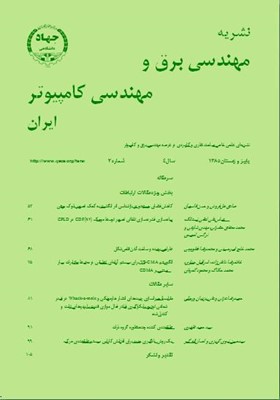تجزیه و تحلیل، طراحی و کنترل فیلتر فعال موازی سه فاز با استفاده از روش کنترل مد لغزشی و فیدبک انرژی
محورهای موضوعی : مهندسی برق و کامپیوترمجید نیریپور 1 , علی یزدیان ورجانی 2 , مصطفی محمدیان 3 , حمیدرضا محمدی 4
1 - دانشگاه تربیت مدرس
2 - دانشگاه تربیت مدرس
3 - دانشگاه تربیت مدرس
4 - دانشگاه تربیت مدرس
کلید واژه: اینورترجبرانکننده اکتيو موازيهارمونيککنترل مد لغزشيفيدبک انرژی,
چکیده مقاله :
وجود بارهاي غير خطي و عدم تعادل در شبکه سهفاز، باعث ايجاد هارمونيکها و تلفات در شبکه ميشود. اعمال فيلترهاي اکتيو و پسيو از جمله روشهاي معمول کاهش يا حذف اين اثرات ميباشد. فيلترهاي پسيو در فرکانس خاص طراحي، و هارمونيک معيني را حذف ميکند و عيب آن امکان رزنانس آن با امپدانس شبکه معادل متصل به آن، و اندازه بزرگ المانهاي آن ميباشد. استفاده از فيلتر اکتيو مشکلات فوق را برطرف و علاوه بر حذف هر هارمونيک دلخواه به طور مجزا يا همگي با هم امکان رزنانس با شبکه نيز نخواهد داشت. از مشکلات اين فيلترها سرعت پاسخ ديناميکي محدود بوده که در نتيجه هارمونيکها را در حالت دائم مورد نظر قرار ميدهند. در اين مقاله اينورتر مورد استفاده در فيلتر اکتيو بر خلاف روشهای قبلی تحليل تکفاز، به صورت دقيقتر يعنی تحليل همزمان سهفاز مورد بررسی قرار گرفته است. همچنين اثر اهمی سلفهای مسير فازها نيز منظور شده است. استفاده از روش کنترل مد لغزشي و فيدبک انرژی خازنها سرعت پاسخ ديناميکي فيلتر را به طور مؤثري نسبت به روشهاي قبلي بهبود داده و قادر است نامتعادلي بار و هارمونيک را سريعاً جبران نمايد.
The presence of nonlinear and unbalance loads in a three-phase network causes harmonics generation and dissipation in power network. One of the usual methods used for decreasing and eliminating these effects is the application of active and passive filter. The passive filter is designed for a particular kind of frequency and therefore eliminates a particular harmonics. Its weakness, however, is the possibility of its resonance with the equivalent network impedance and the large size of its elements. The active filter helps to remove the above problems. Moreover, this filter causes the harmonics to be rejected individually or all together and prohibits the occurrence of resonance with the network. One of the problems of these filters is the limited dynamics response that considers the steady state of harmonics. In this paper, unlike the previous methods on single phase analysis, the inverter used in active filter is analyzed more precisely, i.e., the simultaneous three- phase analysis. The ohmic effect of phase-inductances is also taken into account. The inverter control system makes use of two internal and external loops. The external loop produces suitable signal for on/off switching through sliding mode control. The internal loop utilizes energy feedback to adjust the capacitor voltages. This new method effectively improves the speed of dynamic filter response in comparison with the previously reported methods and is able to quickly compensate harmonics and load unbalancing.
[1] M. Aredes,"Active Power Line Conditioners, Ph.D. Thesis, Institute fur Allgemeine Elektrotechnik, Technical University of Berlin, 1996.
[2] J. Miret and L. Cruz, "A simple sliding mode control of an active power filter," in Proc. of IEEE Power Electronics Specialists Conf.,pp. 1052-1056, 2004.
[3] H. Chin-Yuen and W. Horng-Yuan, "A new single-phase active power filter with reduced energy storage capacitor," in Proc. IEEE Power Electronics Specialists Conf., pp. 202-208,1995.
[4] M. C. Benhabib and S. Saadate, "New control approach for four-wire active power filter based on the use of synchronous reference frame,"Electric Power System Research, vol. 73, no. 3, pp. 353-362, 2005.
[5] N. Mabrouk, F. Fnajech, K. Al-Haddad, and S. Rahmani, "Sliding mode control of a 3-phase-shunt active power filter," in IEEE Conf., On Industrial Technology, vol. 1, pp.597-601, 10-12 Dec. 2003.
[6] V. Cardenas, N. Vazquez, C. Hernandez, and S. Horta, "Analysis and design of a three phase sliding mode controller for a shunt active power filter,” in Proc. IEEE Annual Power Electronics Specialists Conf., vol. 1, pp. 219-223, 1999.
[7] V. Cardenas, N. Vasquez, and C. Hernandez, "Sliding mode control to a 3Φ shunt active power filter using compensation with instantaneous reactive power theory," in Proc. 29th Annual IEEE Power Electronics Specialists Conf., vol. 1, pp. 236-241, 17-22 May 1998.


